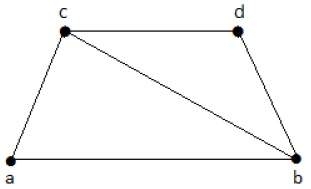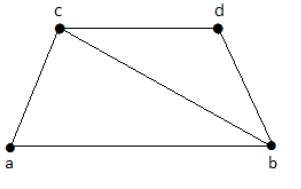Vertex Covering
-
13-09-2020 - |
Question
Vertex Covering
A covering graph is a subgraph that contains either all the vertices or all the edges corresponding to some other graph. A subgraph that contains all the vertices is called a line/edge covering. A subgraph that contains all the edges is called a vertex covering.
Let 'G' = (V, E) be a graph. A subset K of V is called a vertex covering of 'G', if every edge of 'G' is incident with or covered by a vertex in 'K'.
Example
Take a look at the following graph −

The subgraphs that can be derived from the above graph are as follows −
K1 = {b, c}
K2 = {a, b, c}
K3 = {b, c, d}
K4 = {a, d}Here, K1, K2, and K3 have vertex covering, whereas K4 does not have any vertex covering as it does not cover the edge {bc}.
Minimal Vertex Covering
A vertex 'K' of graph 'G' is said to be minimal vertex covering if no vertex can be deleted from 'K'.
Example
In the above graph, the subgraphs having vertex covering are as follows −
K1 = {b, c}
K2 = {a, b, c}
K3 = {b, c, d}
Here, K1 and K2 are minimal vertex coverings, whereas in K3, vertex 'd' can be deleted.
Minimum Vertex Covering
It is also known as the smallest minimal vertex covering. A minimal vertex covering of graph 'G' with a minimum number of vertices is called the minimum vertex covering.
The number of vertices in a minimum vertex covering of 'G' is called the vertex covering a number of G (α2).
Example
In the following graph, the subgraphs having vertex covering are as follows −
K1 = {b, c}
K2 = {a, b, c}
K3 = {b, c, d}

Here, K1 is a minimum vertex cover of G, as it has only two vertices. α2 = 2.
